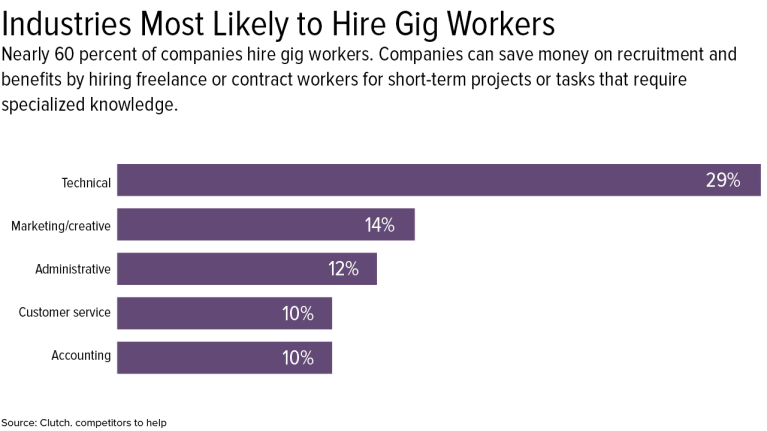Often in today's workplace, you might have 9-to-5 employees working with independent contractors who take home higher pay and enjoy more-flexible schedules than their counterparts. These so-called gig workers may not have to attend department meetings, submit to traditional performance reviews or even abide by the company's dress code.
And that means it could be tricky managing these two very different types of employees.
"If you have two equally skilled workers seated next to one another, where one is a gig worker and the other is not, the relative freedom of the gig worker could result in some resentment" among nongig workers, said Michael Pilnick, executive vice president and head of HR at First Advantage, a global background screening company.
Gig Work Is Growing
Gig work has traditionally been the realm of creative professionals and those whose work is project-based, such as writers, designers, IT professionals and coaches. Lately, however, such workers are a growing presence in the insurance, education, health care, legal and tax-preparation industries.
The Federal Reserve says gig workers could be anyone from a babysitter to an Uber driver. According to that definition, there are as many as 75 million gig workers in the U.S.
Nearly half of executives (47 percent) say they are looking to hire contractors to fill management and senior executive roles, according to a study by Mavenlink, which sells collaboration software.
For a company, one of the most significant advantages to hiring a gig worker is cost savings.
"Generally speaking, independent contractors don't get the traditional benefits of employment, like insurance, sick days, [or] holiday and disability pay," said Jeff Kreisler, editor-in-chief of PeopleScience, which studies how worker behavior affects businesses. "They also [don't have to pay] the employer subsidy for Social Security and Medicare and … don't have [a company's financial] support to save for retirement." In addition, he noted, gig workers may be less likely to sue employers, as they may not be protected by federal and most state labor laws.
Yet according to the Mavenlink study, most companies (69 percent) don't hav ethe support or policies in place to manage gig workers. Moreover, 77 percent said they don't even comprehend what's required to manage them.

[SHRM members-only toolkit: Developing and Sustaining Employee Engagement]
Performance Expectations and Management
How should management, discipline and performance reviews be different for gig workers than for regular employees?
In general, because gig workers aren't typical employees, companies would provide minimal managerial guidance, Pilnick said.
"They would provide quality work and you'd keep leveraging their services, or they would provide work you were not interested in and you'd fail to renew the contractual relationship. The downside is if they don't meet your expectations, you're bound to the contract through its duration."
It may be more appropriate for customers or clients of the independent contractor to assess the latter's work, said Alonzo Martinez, associate counsel of compliance with background screening company HireRight. "Let the individuals who are using the gig-economy worker's services do the talking."
Nor should company managers discipline gig workers as they would regular employees, Pilnick said. "The most you can do is provide negative feedback and opt not to contract that individual in the future."
Another area in which managing gig workers may differ from managing traditional employees is in mentoring and future planning.
"There is not really a career path for a gig worker in a specific organization," said Marc Solow, director of HR shared services at Deloitte. "The coaching of gig workers is optimized for contribution on the task or project at hand or for the duration of the contract, versus long-term career, skill and experience development."
Because gig workers can miss out on the skills development, mentoring and social support that come with permanent employment, Kreisler noted, "encourage them to create networks of similarly situated gig workers inside and outside the organization."
As for motivating the gig worker, Kreisler suggested that you give them as much autonomy as possible.
"Don't inhibit them and make them conform to unnecessary procedures or rules. That's likely to negate the positive features of the work and make them resent it. You want them passionate and invested—for their good as well as that of the company."
Resentment Among Regular Workers?
Gig workers can typically schedule their working hours. And the greater the skill set and demand for the worker's expertise, the better the compensation and the choices of projects the worker can take on.
"They're able to control their work and income and negotiate regularly for payment according to their value in the moment," Kreisler said. They may not have to work regularly onsite, move for a job or deal with office politics.
Traditional employees might complain or feel resentful toward gig colleagues who don't have to attend meetings, can arrive late and leave early, and who are likely earning more than the regular employees, Kreisler said.
"Anytime people are able to compare themselves to others, it creates the potential for jealousy, resentment or regret," he said. "The best solution is to provide a broader perspective. You can say, 'Yes, Roger makes $200 more per week than you and gets to leave at 4:30 to pick up his kids, but he gets no insurance, 401(k) match nor job security."
Managers might also work with regular employees to arrange schedules that support work/life balance, Solow said.
"It's up to the employer and HR to make sure that all employees feel valued," he said. "Open, direct communications, flexibility in hours and location, and learning and job opportunities are all ways to improve employee satisfaction."
Potential Legal Risks
It's important that managers be wary of requiring gig workers to do things that may make them appear to be regular employees. If they're managed in a traditional manner, the law might characterize them as traditional employees, at which point a company could be responsible for providing benefits such as health care insurance and a 401(k).
Finally, Martinez said, remember that even though gig workers aren't traditional employees, they are working inside your company and represent your company to clients and customers.
"A consumer generally cannot differentiate between a gig-economy worker and your direct employee," he said. "Gig-economy workers not only have access to your clients, but they typically have the same access to workspaces and intellectual property as traditional employees. In some cases, you could also be liable for their negligence.
"It's important to ensure that a gig worker is who they say they are, has the credentials that they purport to have and can be trusted around your clients. A robust background screening program can help protect your organization from engaging a gig-economy worker that isn't befitting of your brand."




